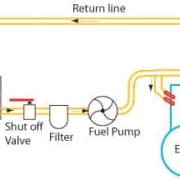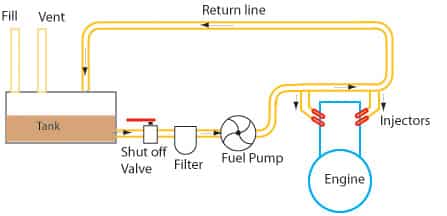The Fuel System – Getting Familiar with a Charter Boat
While it is reasonably rare to have a fuel problem on a charter it can certainly happen and you should be prepared to apply the (sometimes simple) solution below.
The engine will start to sputter or hesitate; just enough for the alert skipper to notice. This will proceed to more prolonged hesitation until the engine stalls out. No alarm sounds in most boats. When the engine shuts down, take measures necessary to assure the crew’s safety and move the boat to a safe area in any way possible before inspecting to locate the problem.
Fuel from the tank(s) is delivered through a shut-off valve to the primary fuel filter, where water is separated and particulate matter up to 30 microns is eliminated. The fuel then travels to the lift pump, which sustains an even fuel flow to the engine. Here there is usually a lever with which we can manually pump fuel. A fuel hose leaves the lift pump and travels to the secondary fuel filter, and then to the injector system; first to the injector pump. Here, the fuel is pressurized to hundreds of psi and is delivered in metal pipes to the injectors. Here, fuel is mixed with oxygen and atomized; and then sprayed into the compression chambers in very precise amounts. A piston compresses this mixture until ignition (Diesel ignites under compression only, not a spark like gasoline). A second, or return line, directs unburned fuel back to the fuel system.
Fuel contaminated with water, metal debris, or algal slime can clog the fuel line between the tank and the primary filter, or within that filter. To test for obstruction, on the injector pump, loosen the nut from the fuel filter intake. Either operate the lift pump or have a mate operate the engine ignition and watch at the nut for fuel flow. Fuel should spurt freely from the fitting; if not there’s an obstruction.
At that point, close the valve from the fuel tank, remove the top of the primary fuel filter, and examine the filter element. Replace the element if it is coated with debris, refill the filter with clean diesel fuel, and replace the top with an O-ring.
If the primary filter is clean, remove the fuel line from the primary fuel filter, and either insert a metal rod or blow through it to push obstructions back into the tank. Re-connect hoses and test for fuel flow once again. In most cases, this corrects the problem; if not, continue to trace the hose toward the engine, replace a clogged secondary filter, and blow out lines as required. Once normal flow is restored, tighten the injector fitting nut, and start the engine.
If you can’t remember all that, it’s simple enough to remember that somewhere between the tank and the secondary filter there is a clog and you’ve got to clean it out. The filters are a good place to start, and certainly, water in the filter is one of the first things to think about.
Air in the Fuel System
Air in the fuel lines will also shut down a diesel engine. Air can be introduced by loose fuel lines, when investigating a fuel problem or if the engine has been run dry of diesel. Air is removed (bleeding the fuel system) by a similar technique used to push fuel through to the injector system. Trace the metal line from the injector pump to the closest injector, and unscrew the fitting just a bit. Either manipulate the lift pump lever or have someone crank the engine over. Bubbles will come out of the fitting, but eventually, clear fuel will flow; now tighten the fitting and start the engine. If it does not start, continue the procedure with successive injector lines until they all emit clear diesel fuel.







